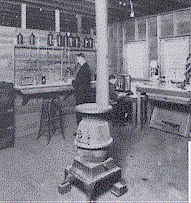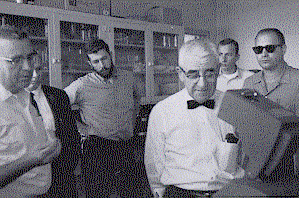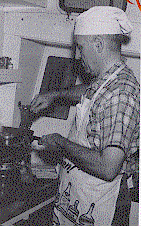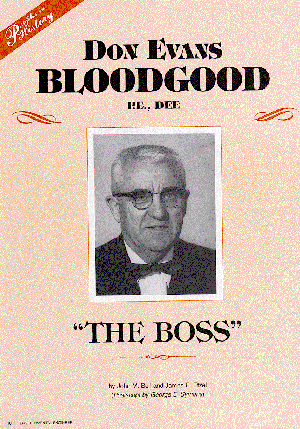Don Evans Bloodgood(1903-1985)Environmental Engineering Purdue University - School of Civil Engineering Authors:Professor Emeriti John Bell and James Etzel |
 |
Don Evans Bloodgood(1903-1985)Environmental Engineering Purdue University - School of Civil Engineering Authors:Professor Emeriti John Bell and James Etzel |
 |
NOTE: Permission to electronically present the following special article ("AAEE Environmental Engineer," October 1995) entitled, "Professor Don Evans Bloodgood - Profile in History," has been given by the American Academy of Environmental Engineers soley for this Purdue University Web Home Page. Subsequent duplication and reuse of this paper is not allowed; should you desire futher copies, please contact the Academy directly, c/o Editor-in-Chief William C. Anderson, Annapolis, Maryland 21401 (410-266-3311).
After fifty-one years of Purdue University's Industrial Waste Conferences, it's difficult to remember a time when the annual event wasn't held. The Purdue conference was the brainchild of Don Evans Bloodgood (1903-1985), the pioneer who dreamed up and pulled off the first such gathering on November 29, 1944, long before industrial waste management had drawn much attention as an important area of environmental engineering. Under Don's direction, the Purdue conference and its well-read Proceedings became institutions in the newly emerging industrial waste field. The annual event provided the locus for disseminating information and techniques, and it had a major influence on the development of industrial waste practice.
Fostering education and awareness of timely topics in environmental engineering was one of Don's many roles as a professor at Purdue University; a researcher, writer and magazine editor; a member of several public boards and commissions; a consultancy to industry; and a friend and counselor to students and colleagues alike. The legacy left behind since Don's death in February 1985 includes the more than 125 graduate students who were enthused and motivated by the professor affectionately and respectfully known to all as "The Boss."
Don was born in Elkhorn, Wisconsin on February 1, 1903, the only child of Erwin and Anna Bloodgood. Don's father owned and operated the Peck's Station country store, which adjoined the family's house along with a small farm where they raised chickens, sheep and vegetables. Don attended grade school in a one-room schoolhouse located about a mile down the dirt road from his home. After completing his studies there, Don moved into town to attend high school, spending each school year at the home of his aunt.
The Bloodgood's were active members of the Bethel Methodist Church. The church held special significance for Don, for this was where he met his future wife, Margaret Austin, the preacher's daughter. They were married in 1927. The couple's first son, Donald A., was followed later by twins, Thomas W. and Natalie Ann.
 Early Years: Milwaukee
Sewage Commission laboratory, circa 1927
Early Years: Milwaukee
Sewage Commission laboratory, circa 1927
Don enrolled at the University of Wisconsin, becoming the first member of his family to
attend college. He received a B.S. degree in Civil Engineering in 1926 after completing
his thesis on "Sealing Methods of the BOD Test." That same year, the young
engineer landed his first job as a research chemist with the Milwaukee Sewage Commission,
where he remained through 1929. Don's duties included preparing routine laboratory tests
to monitor the operation of their sewage treatment plant. He also conducted water surveys
on Lake Michigan and the Milwaukee Harbor and was responsible for dealing with the public
when conditions at the plant resulted in odor problems.
In 1930, Don and Margaret headed off to Indianapolis, where Don signed on as a research chemist and sanitary engineer with the Indianapolis Sanitary District. As the engineer in charge of operating the District's activated sludge plant, his first assignment was to conduct a study on activated sludge filtration. During this time, Don also continued his advanced studies at the University of Wisconsin, using the results of his laboratory and semi-plant-scale tests as the basis for his thesis.
Don enjoyed a 13-year career at the Indianapolis Sanitary District. He served as manager of the District's sewage disposal and garbage reduction plants before being promoted in 1936 to District Superintendent, a post he held until departing for Purdue University in 1943.
Throughout these years, Don authored technical papers on a regular basis. Articles published under his name in technical journals of the 1930's included early reports on plant-scale studies of activated sludge performance and process, laboratory equipment developments for microbiological activity, and the use of deep lagoons for sludge digestion and stabilization. Don continued his writing throughout the 1940's and '50s with a series of articles in Sewage Works Journal; the articles were later compiled into a book for wastewater treatment plant operators. And when Industrial Wastes magazine was founded, Don was chosen as the publication's first editor.
In September 1943, Don joined the faculty of Purdue University as an associate professor, at the invitation of Professor R.B. Wiley. Don was handed the task of developing a program of teaching, research, and extension activities in sanitary engineering that would make Purdue a world leader. His earliest years on the job were devoted to fostering the undergraduate and masters degree programs, but he soon expanded his focus to include a doctoral program. Don accomplished his objectives well beyond most expectations. Recognition of his successful efforts came in the form of a promotion to full professor in 1947.
 The Teacher: Don truly
enjoyed time with his students, circa 1963
The Teacher: Don truly
enjoyed time with his students, circa 1963
It was not long before Don acquired the nickname, "The Boss," from students
fortunate enough to have been in his classes and worked with him on thesis topics.
Although he never acted the part of a boss in his daily role as a professor or
administrator, this affectionate title clearly indicated the respect he had won. The real
testament to Don's legacy at Purdue lies in the many graduates who went on to make their
mark in academe, consulting, government, and industry. Among the 125-plus graduate
students, both masters and doctoral, who had Don as their major professor are George
Erganian (deceased July 1995), managing partner of HNTB Corp., and Charles C. Johnson,
former administrator of the Federal Water Quality Administration. Don never forgot a
student he had known in his classes and was never too busy to visit and talk with them.
While taking care of his degree student's Don also wasted no time in building Purdue's university extension and continuing education activities in sanitary engineering. One such extension tool, which he launched during his first year at Purdue, was the Sanitary Engineering Newsletter. For nearly thirty years, Don edited the newsletter each month until his retirement in June 1971. The newsletter was quite popular; its circulation started at about 100 and grew to over 1,500 in 1971. Since that time, the publication has been renamed Environmental Engineering News and reached a circulation of over 10,000, with copies sent to over 54 countries throughout the world.
Within a year of his arrival at the University, the new associate professor hatched the idea that led to the first Purdue Industrial Waste Conference. Don envisioned the event as an opportunity to bring together experts from several sectors - academe, industry, government, and the engineering profession - to focus attention on the important, yet still fledgling, field of industrial waste management. The Purdue conference was the first of its kind and was the forerunner of similar conferences held throughout the world.
The initial gathering on November 29, 1944 drew 203 attendees and was followed by increasingly larger turnouts year after year. From the very beginning, one of the secrets to Don's success was his skill in involving professor associations, industry organizations and governmental officials in planning the conferences. Don enlisted the cooperation and support of several groups, including the Indiana Sewage Works Association, the Indiana Manufacturers Association and various state associations representing the canning, brewing, paper manufacturing and other industries, as well as governmental representatives from the Indiana Conservation Department, the State Board of Health, and newly formed Indiana Stream Pollution Control Board.
During the early years, Don carried out nearly all of the detail work involved with organizing these Purdue conferences. He arranged the speakers, scheduled the sessions, obtained audio-visual equipment, presided over opening and other general sessions, and even helped participants find housing and transportation. After each conference, Don edited all of the conference papers for publication in the Proceedings. Throughout the world, the design, construction, and operation of waste treatment facilities incorporate technologies first reported on at a Purdue Industrial Waste Conference.
To this day, the conference and its proceedings are known worldwide as "the" authority on industrial waste. The annual event has attracted many outstanding engineers and scientists from around the world, such as K. Kato of Japan; W. Haltrich and Has Gotte of Germany; G.J. Stander of England; T. Simensen of Norway; P. Adenma of The Netherlands.
As an early pioneer in the field of industrial waste management, Don started consulting on industrial waste treatment and disposal problems in 1943. His first client, Weston Paper Co., remained a client for over 40 years. Don's other clients included nationally known companies such as Proctor and Gamble, Maytag, Rock Island Refinery, Scott Paper Co., Pfizer and Whirlpool, as well as a number of relatively small regional concerns. In 1971, Don received a distinguished service award from the National Clay Pipe Institute.
One of Don's pet projects was researching and co-designing the Sanitoi "sewerless toilet." The system was studied in the laboratory with the aid of graduate students and staff as "donors." The system was marketed for several years after patents were issued.
In 1945, Don was appointed to the Indiana State Board of Health. He continued to represent the engineering profession on the board for 34 years. In this capacity, he helped institute and implement many of the state's existing pollution-control regulations. Don's work extended to matters involving all phases of public health, from nutrition to nursing homes, in addition to his specialty in sanitary engineering. Don also served on the advisory committee to the Ohio River Valley Sanitation Commission. For these and other public service activities, Don was twice named a "Sagamore-of-the-Wabash" by Indiana governors. At the national level, Don was an advisor to Vice President Nelson Rockefeller during development of the report on the National Commission on Water Quality.
Throughout his career, Don was active in several professional societies. He was president of the Central States Sewage Works Association and was founder and first president of the Indiana Water Pollution Control Association. He also served as a director-at-large of the Water Pollution Control Association (now the Water Environment Federation), which over the years has awarded him the Charles Alvin Emerson Award (for meritorious service), the Gordon Maskew Fair Medal (as an engineering educator), and the Arthur Sidney Bedell Award (for service to the Central States region). WEF also accorded Don the status of Honorary Member, indicating preeminence in the water pollution control field. Don was president of the Indiana Section of the American Society of Civil Engineers. One of the most treasured accomplishments was his election to honorary ASCE membership in 1981.
 The Cook: Don on "The
Angus," a fishing boat he and his friends frequently enjoyed, here on Lake Michigan,
circa 1954
The Cook: Don on "The
Angus," a fishing boat he and his friends frequently enjoyed, here on Lake Michigan,
circa 1954
While maintaining a busy professional and teaching agenda, Don found time to engage in one
of Indiana's own special pieces of Americana, namely, the Indianapolis 500 auto races. As
a friend of Indianapolis Motor Speedway owner and president Tony Hulman, Don served
several years in the coveted position of chief parking attendant at the Speedway.
Arrangements were also made for establishment of the Tony Hulman Fund at Purdue. The fund
was created specifically for Don to use as needed for student and staff purposes.
Don's community service included his work as a Kiwanis International member and hospital volunteer. He supported the Boy Scouts as a council committee member and stayed active in his college fraternity as an alumnus advisor. And, of course, to his students, Don was a friend counselor, and guide in charting and developing their careers. Throughout his own career, Don always found time to spend with his wife and three children. In his later life, his pride was his grandchildren and their accomplishments.
